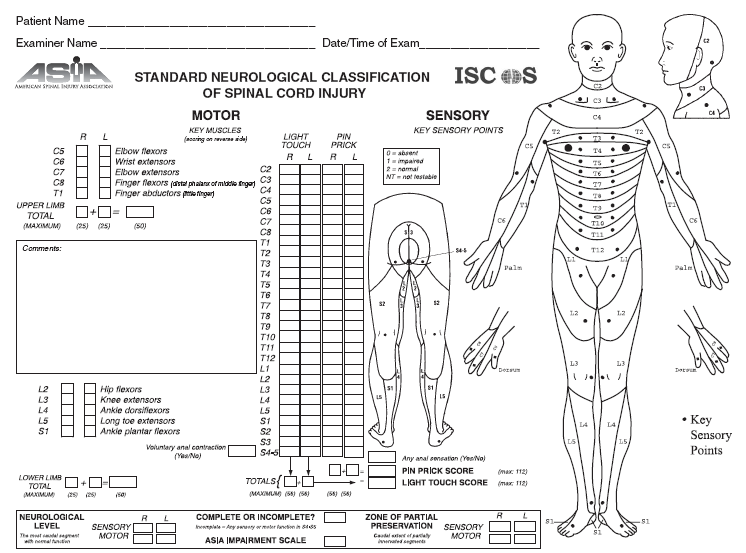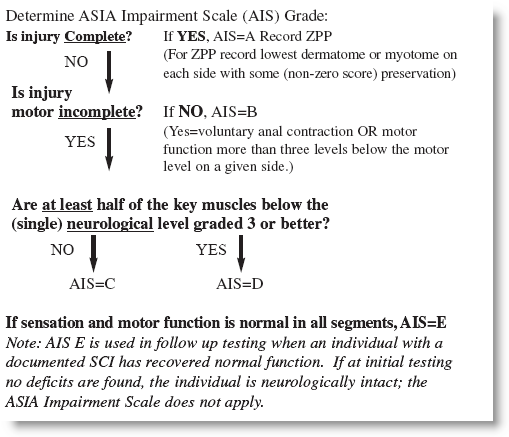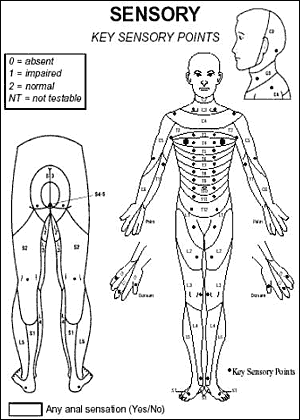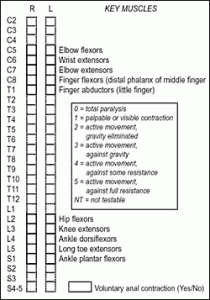Last Updated on May 21, 2022
ASIA score is the score developed by the American Spinal Injury Association for essential minimal elements of neurologic assessment for all patients with a spinal injury. This is based on scores as assessed by the examiner and is popularly called ASIA score.
These minimal elements are strength assessment of ten muscles on each side of the body and pin-prick discrimination assessment at 28 specific sensory locations on each side.
How To Calculate ASIA Score?

Sensory Examination
The sensory levels are scored on a 0 to 2 scale for each dermatome. If the body is divided into two identical halves there are 28 key sensory points to be tested. Each dermatome is tested for light touch and pinprick sensations and labeled as NT (not testable) if cannot be tested.
Otherwise, the following scores are given to each sensory point
- 0 – The sensation is absent
- 1 – The sensation is present but impaired
- 2 – The sensation is normal
Scores are individually tested for both light touch and pinprick are normal. The maximum possible score is 112 points for each of them for a patient with normal sensation.
In addition, presence or absence of anal sensation is noted.
Motor Examination
10 key muscles, 5 in the upper limb and 5 in the lower limb are tested. Five specific upper extremity muscles, one from each respective segment of the cervical cord, are scored on a 5-point muscle grading scale. Five specific lower extremity muscles are similarly scored.
Muscle strength is graded as
- 0 Total paralysis
- 1 – Palpable or visible contraction
- 2 – Active movement, full range of motion, gravity eliminated
- 3 – Active movement, full range of motion, against gravity
- 4 – Active movement, full range of motion, against gravity and provides some resistance
- 5 – Active movement, full range of motion, against gravity and provides normal resistance [Muscle able to exert, in examiner’s judgement, sufficient resistance to be considered normal if identifiable inhibiting factors were not present]
- NT – not testable. Patient unable to reliably exert effort or muscle unavailable for testing due to factors such as immobilization, pain on effort or contracture.
The sum of all 20 muscles yields a total motor score for each patient, with a maximum possible score of 100 points for patients with no weakness. A different score, however, for upper limbs and lower limbs can be calculated making it 50 maximum for both upper and lower limbs.
Voluntary anal contraction is also noted.
Determine Single Neurological Level
After motor and sensory levels have been determined, the information is assimilated for determining a single neurological level. This is important because the sensory and motor level may differ.
The neurological level is the lowest segment where the motor and sensory function is normal on both sides and is the most cephalad of the sensory and motor levels determined in sensory and motor examination.
Complete or incomplete spinal cord injury
The injury is complete if there is
- No voluntary anal contraction
- S4-5 sensory scores = 0
- no anal sensation = No
Otherwise, the injury is incomplete.
Grading of Impairment
The ASIA impairment scale describes a person’s functional impairment as a result of their spinal cord injury.

A- Complete
No motor or sensory function in the lowest sacral segment (S4-S5)
B- Incomplete
Sensory function below neurologic level and in S4-S5, no motor function below neurologic level
C- Incomplete
Motor function is preserved below neurologic level and more than half of the key muscle groups below neurologic level have a muscle grade less than 3.
D- Incomplete
Motor function is preserved below neurologic level and at least half of the key muscle groups below neurologic level have a muscle grade >3
E- Normal
Sensory and motor function is normal
ASIA elements have better reproducibility, they constitute a minimal data set desirable in all spinal injury patients for accurate communication across the personnel. It also makes follow-up easy to assess.
Clinical evaluation and management, however, require a neurologic assessment extending beyond the essential examination elements recommended by ASIA. Assessment of lower extremity and perineal reflexes is critical to determine the severity of neurologic involvement. These elements are considered optional in the ASIA standards since they do not meet sufficient reproducibility criteria.
Categorization of a specific patient into a specific division of classification requires some subjective judgment. The variability in these judgments makes comparisons difficult and ASIA has defined these terms with specific criteria for clarity in current and future discussions. These specific definitions will improve the categorization of spinal cord injury patients in scientific communication and allow more meaningful analyses.
Key Sensory Points In ASIA Score

A dermatome is a patch of skin that is innervated by a given spinal cord level. While each spinal nerve has a specific dermatomal point for testing that nerve. The image above is from American Spinal Injury Association and outlines the distribution of different spinal nerves which can be used for testing them and conducting a spinal examination
It must be noted that the outline is supposed to be a rough guide and there may be overlaps of different dermatomes, especially in the transitional areas. Moreover, the dermatomes can expand or contract following an injury, depending on the plasticity of the spinal cord.
Key Sensory Points
ASIA names key sensory points which are easy to measure.
C2 to C4
- C2 dermatome covers the occiput and the top part of the neck.
- C3 covers the lower part of the neck to the clavicle bone.
- C4 covers the area just below the clavicle.
C5 to T1
These dermatomes are all situated in the arms.
- C5 covers the lateral arm at and above the elbow.
- C6 covers the forearm and the radial side of the hand.
- C7 is the middle finger,
- C8 is the medial aspects of the hand
- T1 covers the medial side of the forearm.
T2 to T12
- T2 covers the axillary and chest region and upper medial aspect of arm.
- T3 to T12 covers the chest and back to the hip girdle.
- The nipples are situated in the middle of T4.
- T10 is situated at the umbilicus.
- T12 ends just above the hip girdle.
L1 to L5
- L1 innervates hip girdle and groin area
- L2 and 3 cover the front part of the thighs.
- L4 and L5 cover medial and lateral aspects of the lower leg.
S1 to S5
- S1 covers the heel and the middle back of the leg.
- S2 covers the back of the thighs.
- S3 cover the medial side of the buttocks and S4-5 covers the perineal region.
- S5 forms the lowest dermatome and represents the skin immediately at and adjacent to the anus.
Key Muscle Groups In ASIA Score or ASIA Impairment Scale
In ASIA Scoring system ten muscle groups innervation by the cervical and lumbosacral spinal cord are tested. The ASIA system does not include the abdominal muscles supplied by thoracic segments because they are not feasible to delineate one from another and because these levels can be better marked by sensory levels.
It also excludes muscles like hamstrings because the segmental levels that innervate them are already represented by other muscles.
However, it must be understood that every muscle received innervation from two or more segments. Therefore the examination does not determine the absolute level of injury but only a gross one.

- ASIA Score Muscle Groups
Arm and Hand
- Elbow flexors (biceps) are innervated by C5
- C6 the wrist extensors
- C7 the elbow extensors (triceps),
- C8 the finger flexors
- T1 the little finger abductor (Movement of the little finger away from others).
Leg and foot
- L2 – hip flexors (psoas muscle)
- L3 – knee extensors (quadriceps)
- L4 the ankle dorsiflexors (anterior tibialis)
- L5 the long toe extensors (hallucis longus)
- S1 the ankle plantar flexors (gastrocnemius)
Anal Sphincter
The anal sphincter is innervated by the S4-5 cord and represents the end of the spinal cord. If the person has any voluntary anal contraction, regardless of any other finding, that person is by definition a motor incomplete injury.
References
- American Spinal Injury Association. International Standards for Neurological Classifications of Spinal Cord Injury. revised ed. Chicago, Ill: American Spinal Injury Association; 2000. 1-23.
- Ditunno JF Jr, Young W, Donovan WH, Creasey G. The international standards booklet for neurological and functional classification of spinal cord injury. American Spinal Injury Association. Paraplegia. 1994 Feb. 32(2):70-80. [Link].